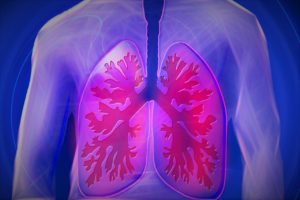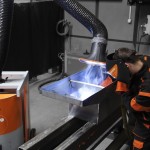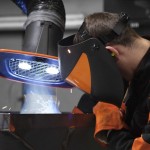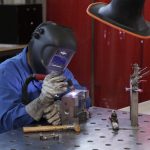Cancer caused by welding – avoiding damage to health
After cardiovascular diseases, cancer is the second leading cause of death around the world. This fact should come as no surprise. Much more interesting is the fact that every second cancer can be avoided. According to new scientific findings, external risk factors were involved in 44 percent of the test group examined. Besides the consequences of an unhealthy lifestyle such as smoking and alcohol consumption, an important risk factor is everyday working life.
Day in, day out, welders are exposed to carcinogenic substances in the workplace. The list of these substances is long: Nickel compounds and VI-valent chromium compounds have long been classified as carcinogenic. Excessive amounts of smoke and dust can also lead to inflammation of the lungs and, in extreme cases, to cancer. Contact and the health consequences that result can be avoided with the proper protective welding equipment measures. This is an important aspect of cancer prevention because, according to the current Lancet study, tumours in the respiratory tract are by far the most common cause of cancer-related deaths, at 36.9 percent of deaths. The most common cause of this is smoking. But, according to the study, high exposure to harmful substances at the workplace also leads to the formation of tumours. Men, for example, are three times more likely to get lung cancer than women. This suggests that men are more likely to work in places where they are exposed to carcinogens.
Carcinogenic substances in welding
Production halls where welding takes place are among the places where carcinogenic substances can be released. Employees inhale the smoke. The pollutants it contains hit the glandular and connective tissue, the so-called epithelium, of the upper respiratory tract directly. Studies have long proven that welding fumes cause inflammatory processes that can then lead to the formation of lung carcinomas. This is particularly the case when a person is subject to long-term exposure. Scientists suspect that these mechanisms affect not only the epithelium, but also other parts of the airways. To date, this assumption has not been scientifically proven. One thing is certain, however: The pollutants contained in welding fumes are hazardous to health and can even lead to lung cancer.
In 2017, the International Agency for Research on Cancer classified welding fumes as carcinogenic. Carcinogenic substances can be released as smoke from coatings and especially the filler material. It should be noted that not every welding process produces the same amount of carcinogenic substances. The electric arc welding of stainless steels is associated with a particularly high load. This produces chromium(VI) and nickel compounds that are particularly harmful to health. Other high-emission processes include metal active gas welding (MAG) and metal inert gas welding (MIG).
How welders protect themselves from carcinogenic substances
To create a working environment as emission-free as possible, the use of extraction units is advisable. Since there are different systems for particularly effective extraction in the area of origin, which is also mandatory for manual welding, users should definitely familiarise themselves with the conditions and the working environment before buying. KEMPER offers the following suction and filter units to protect welders from carcinogenic substances at the workplace:
- Mobile extraction units with extraction arms for source extraction are suitable for occasional to non-stop operations. With an extraction arm that can be swivelled through 360° and their great mobility, the units create maximum flexibility at the workplace.
- Stationary extraction units and systems are used at workplaces characterised by a fixed position in the production hall. Ducting systems connect the units with extraction arms, extraction hoods, extraction tables and robot cells.
- High-vacuum extraction units and systems are suitable for both standalone and multiple workplaces. The pollutants are extracted directly at the welding extraction torch.
- General ventilation systems are an addition to local exhaust ventilation. They reduce the concentration of hazardous substances in the entire general ventilation system, and this effect benefits all employees.
Whether mobile extraction unit or general ventilation system, the systems protect employees from carcinogenic particles and thus from health risks. Because welding involves many risks that seriously endanger the health of employees. The good news is, however, that if employers use the right equipment, they can protect their employees and create a safe workplace.





